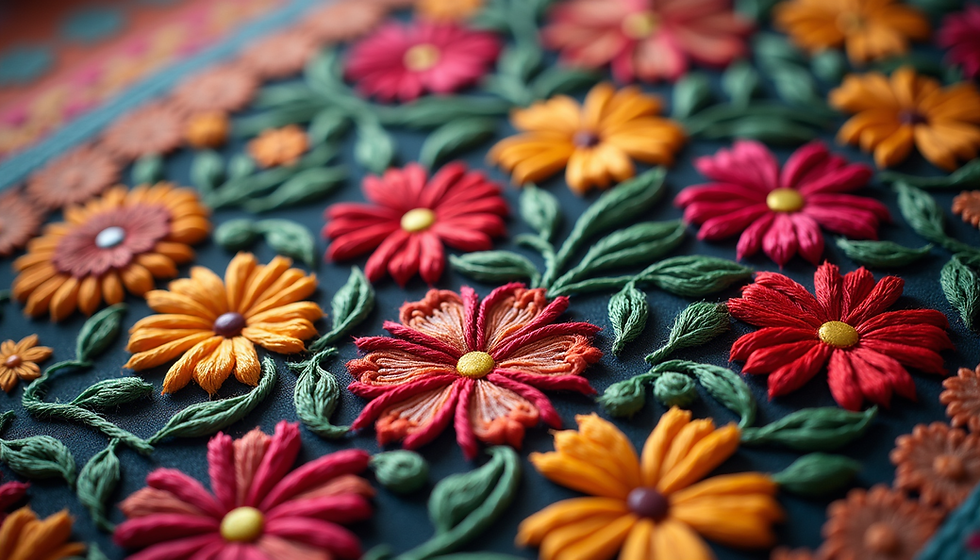- jkartsfoundation
- Apr 30
- 4 min read
Kashmiri Embroidery Styles and Their Influence on Indian Textiles

Kashmir, often referred to as the "Paradise on Earth," is not only known for its stunning landscapes but also for its exquisite and intricate handicrafts. Among the most prized of these crafts is Kashmiri embroidery, a legacy that has transcended generations and continues to shape the Indian textile landscape. This art form, rooted in the cultural and artistic history of the region, reflects a confluence of Persian, Central Asian, and indigenous styles, resulting in a distinctive aesthetic that resonates across India.
Kashmiri embroidery traces its roots to the medieval period when Persian influence permeated the Valley due to the influx of artisans under the patronage of various rulers. Over time, the embroidery evolved into a regional specialty, practiced by both men and women, and became an integral part of the local economy. Historical texts and records from the Mughal era mention the patronage of Kashmiri shawls and garments, particularly by Emperor Akbar, who encouraged the development of crafts in the region.
Distinctive Styles of Kashmiri Embroidery
Kashmiri embroidery is not a monolith; it encompasses several styles, each with unique techniques, motifs, and cultural significance. Among the most well-known are:
1. Sozni Embroidery
Sozni is the most delicate and refined form of embroidery found in Kashmir. Worked with fine needles and silk or cotton threads, it features symmetrical patterns, often floral or paisley motifs, rendered on Pashmina shawls, woolen garments, and sarees. Sozni is usually done on both sides of the fabric, making it reversible and enhancing its value.
2. Aari Embroidery
Aari or hooked needle embroidery is characterized by chain-stitch work, typically done using a specialized hooked needle called an "aari." The designs are larger and more vibrant than Sozni and often cover greater surface areas. Aari is extensively used on woolen pherans, cushion covers, and drapery fabrics.
3. Tilla Embroidery
Tilla embroidery is opulent and predominantly used for bridal and ceremonial attire. It involves the use of gold or silver metallic threads to create rich patterns on velvet, silk, and wool. Traditionally done by hand, Tilla embroidery is painstaking and labor-intensive, contributing to its exclusivity.
4. Crewel Embroidery
Crewel work is a type of surface embroidery using wool yarn, often on cotton or linen fabric. This style is typically used for home furnishings like curtains, bed covers, and upholstery. The motifs are bold and stylized, and the texture is heavier, making it ideal for decorative purposes.
Kashmiri embroidery is steeped in symbolism. Floral designs such as the lotus, chinar leaves, and almond blossoms are prevalent, reflecting the natural beauty of the Valley. Paisley, or the "buta," is perhaps the most iconic motif, believed to symbolize fertility and eternity. These designs not only beautify textiles but also serve as cultural narratives.
The choice of materials is crucial in Kashmiri embroidery. Pashmina, a luxurious wool obtained from the undercoat of Himalayan goats, is the most preferred base, especially for shawls. Other materials include wool, cotton, silk, and velvet. Artisans use fine needles or hooked tools, and the work can take weeks or even months to complete, depending on the complexity.
Kashmiri embroidery has had a significant impact on textile traditions across India. The fine craftsmanship and luxurious appeal of Sozni and Tilla have influenced bridal fashion in North India. Designers often incorporate Kashmiri motifs and styles into contemporary sarees, lehengas, and dupattas. Furthermore, the techniques have inspired embroidery traditions in states like Punjab and Himachal Pradesh, leading to the fusion of regional aesthetics.
The popularity of Kashmiri embroidery has also given rise to industry collaborations and fashion showcases that highlight the Valley's craftsmanship on national and international platforms. Leading Indian fashion designers have incorporated Kashmiri work into couture collections, further elevating its status.
Embroidery is a livelihood for thousands of artisans in Kashmir. It is often a family trade, passed down through generations. Women, in particular, play a vital role in preserving and propagating these crafts. However, challenges such as market access, middlemen exploitation, and political instability have hindered the full economic potential of this industry.
Efforts by government bodies, NGOs, and cooperatives have been instrumental in providing training, resources, and market linkages to artisans. E-commerce platforms and social media have also enabled direct-to-consumer sales, increasing visibility and demand for authentic Kashmiri embroidery.
Despite its rich heritage and artistic excellence, Kashmiri embroidery faces several threats. The influx of machine-made imitations has diluted the market, and many consumers struggle to distinguish between authentic and fake products. Additionally, political unrest and climate change in the region impact the lives and livelihoods of artisans.
To safeguard this tradition, there is a need for:
Stronger GI (Geographical Indication) protections
Artisan welfare schemes
Digital literacy and branding initiatives
Inclusion of Kashmiri crafts in academic curricula
Kashmiri embroidery is not just an art form; it is a cultural emblem that tells the story of a land, its people, and their heritage. Its influence on Indian textiles is undeniable, weaving through time, geography, and generations. As India looks to preserve its intangible cultural heritage, investing in the artisans and traditions of Kashmir is both a cultural necessity and a national imperative. By valuing and supporting this intricate craft, we not only protect an ancient legacy but also enrich the future of Indian textiles.



Excellent roundup of travel essentials! The oxygen tips were especially useful.
You can also explore Leh Ladakh winter tour packages with Sage Holidays for a magical snow-filled vacation.